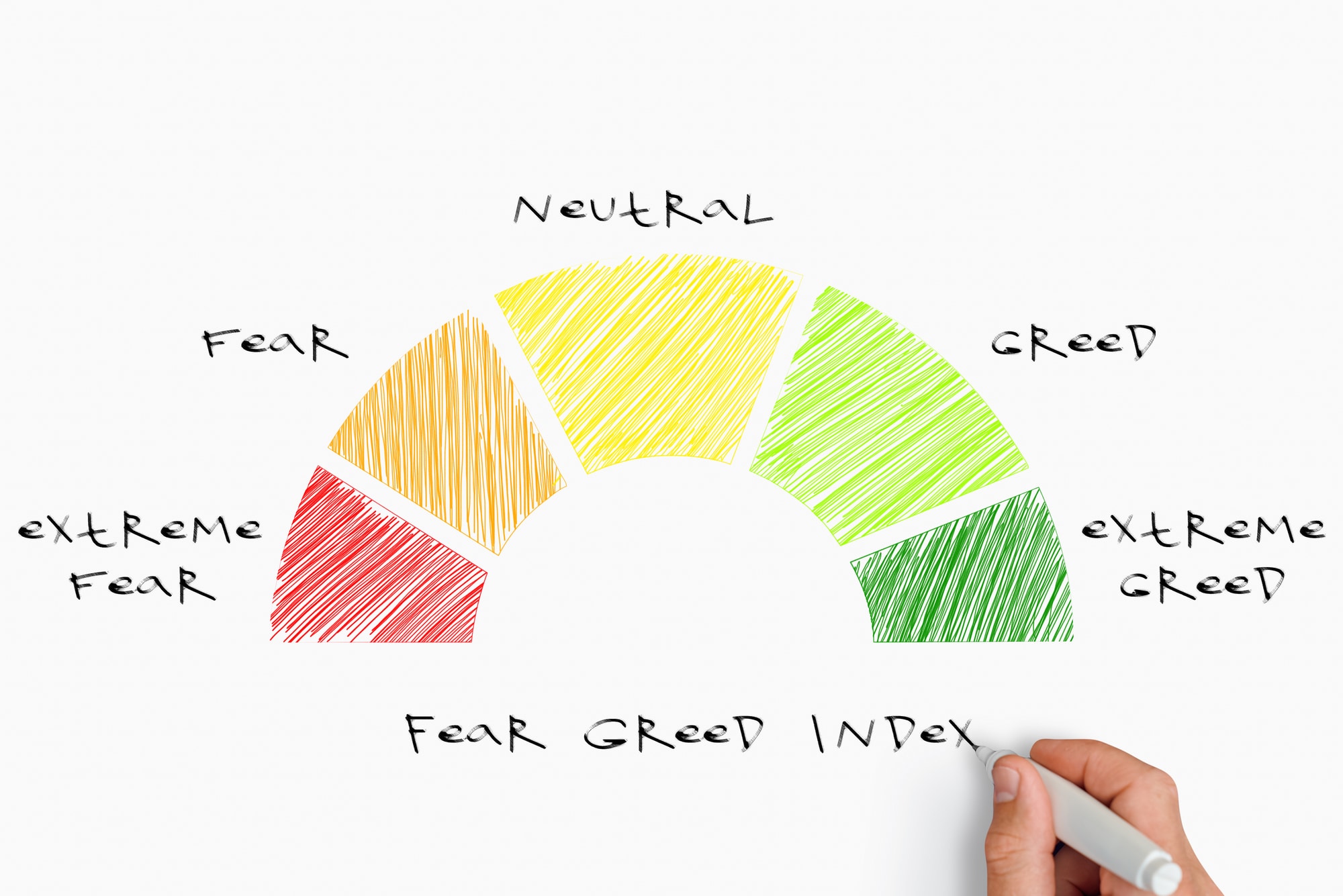Investment decisions should not be made in a vacuum, and investment success with cryptocurrencies hinges on your ability to read the market and its charts and parts. The Fear and Greed index is one way to make sure you consider the context of investor behavior when making market decisions.
Cryptocurrencies have their own Fear and Greed index — which indicates investor sentiment on whether to buy, hold, or sell crypto assets — and helps guide crypto investors to success. For crypto day traders, in particular, consulting this index is one strategy for success. However, all investors can use the Fear and Greed index to their advantage.

What Does the Fear and Greed Index Measure?
Traditionally, this index has been used to measure investor sentiment as it relates to buying and selling. It reduces this behavior down to a single, easy-to-understand number between one and 100. To measure this number, analysts rank sentiment from market performers as well as trading activity. It involves both emotional and rational data.
One lies on the fear side of the spectrum, indicating extreme concern in the market. At one, investors are eager to sell off their crypto. 100 is on the greed side of the spectrum. This indicates a Fear of Missing Out (FOMO) attitude that corresponds with high rates of purchasing.
How does this differ from other market indicators?
The Fear and Greed index and the Standard and Poor’s (S&P) 500 are good examples. The Fear and Greed index measures the general bearishness or bullishness of the market, while the S&P 500 is a statistical measurement of the 500 largest stock companies in the U.S. Further, specific indexes, like the Bitcoin Fear and Greed index, allow investors to target the performance of individual coins.
Meanwhile, the general indicator tells a compelling story about how crypto investments are being viewed by professionals. You can use this number to maximize your investment potential.
Factors That Affect the Fear and Greed Index
It also helps to understand the market factors that make up this index. A lot of data goes into measuring fear and greed in the crypto world. Since this market is highly reactionary to public opinion, that’s an important part of the algorithm.
For example, seemingly any time Elon Musk tweets about crypto, the market shifts. A cute picture of Musk’s Shiba Inu dog can be enough to inspire FOMO purchasing behavior for the Shiba Inu coin. The Fear and Greed index responds accordingly, ranking higher or lower depending on the sentiment.
More quantifiable information and additional factors also go into this ranking, including:
Volatility
Investors would be remiss not to factor volatility into their considerations. That’s why they use Fear and Greed index historical data to shape a better picture of volatility.
The index uses drawdowns, or declines in value, to compare rates of change. Comparisons are made on 30- and 90-day averages. From here, max drawdowns inform the volatility rate, which influences a full quarter of the overall index score. With higher volatility, the Fear and Greed index goes down. With lower volatility, it rises.
Market Momentum
Market momentum is a metric based on the trajectory and size of the market itself, which can vary depending on the coins being ranked.
Momentum tracks the performance of the market against averages, once again in 30- and 90-day timeframes. If the momentum of the market is upward, the Fear and Greed index will also climb, and vice versa. This measurement makes up another 25% of the overall ranking.
Social Media and Surveys
Social media mentions for cryptocurrencies play into index rankings based on historical data. Surveys supplement this data with more quantifiable information from thousands of respondents. The index then crunches this data into a numerical result that influences 30% of the overall Fear and Greed score. Higher public confidence (or courage) in crypto leads to a higher ranking. Less faith equates to a lower score.
Dominance and Trends
Lastly, the crypto Fear and Greed index is determined by the dominance of the coin in question in relation to market trends. Bitcoin, for instance, has long been a dominant cryptocurrency. This helps its confidence on the Fear and Greed scale. However, alternative coins, search engine activity, and audience interest all influence dominance and trends metrics to create a bigger picture of crypto sentiment.
The Fear and Greed index incorporates this data into a value that collectively determines the final 20% of the overall ranking. By understanding how the Fear and Greed index daily reacts to these factors, you can more confidently apply it to your own investments.
How Can You Use the Fear and Greed Index?
Using the Fear and Greed index can be a great way to hone your portfolio and maximize your investments. However, using it effectively requires actionable insights.
Here are a few tips for using the Fear and Greed index to your advantage:
- Sell when the index is reaching peaks (a score of 75 to 100).
- Buy when the index is reaching lows.
- Plan investment and market entries around fearful dips (scores between 25 and 49).
- Assess undervalued currencies.
- Don’t abandon crypto too quickly before making a profit (scores between 50 and 74 are good growth indicators).
One of the best use cases for the Fear and Greed index is as a tool to understand when it’s time for diversification. This is because high volatility and long-term fearful rankings make for a poor investment. In situations like these, seek out other cryptocurrencies to diversify your portfolio and enhance investment security.
Similarly, the height of greed in a market is a good time to seek out up-and-coming alternatives. Learn to read the Fear and Greed index as you plan a thriving and diverse portfolio.
Where to Read the Fear and Greed Index
Learning to read this index requires knowing where to find it. Several options are out there, updated daily, and accessible for investor use. These platforms show current market indicators for large cryptocurrencies. In addition, historical data about the Fear and Greed index is provided to demonstrate a bigger picture.
Assess the data from the following sources:
- Alternative.me Crypto Fear and Greed Index: This resource provides a daily analysis of Bitcoin and other large cryptocurrencies.
- Bitcoin & Crypto Fear and Greed Index: This is another platform providing live insight into big crypto.
- look into Bitcoin Fear and Greed Index: As the name implies, this index is more focused on Bitcoin but can inform the larger crypto market.
Use these tools to explore the larger situation regarding crypto performance, and remember the words of Warren Buffet: “Be fearful when others are greedy and…be greedy only when others are fearful.”




